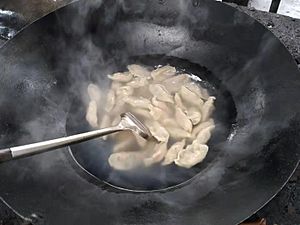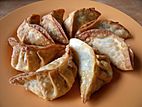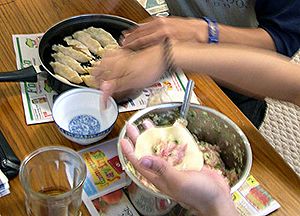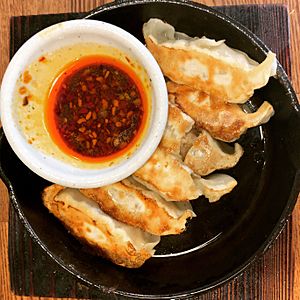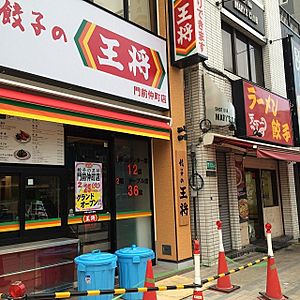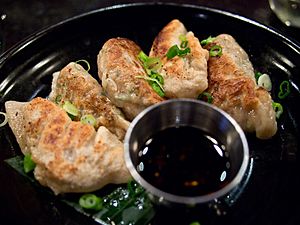Jiaozi facts for kids

A plate of boiled jiaozi with dipping sauce
|
|
| Type | Dumpling |
|---|---|
| Course | Normally as an entree |
| Place of origin | China |
| Region or state | East Asia |
| Serving temperature | Hot |
| Main ingredients | Dough, ground meat or vegetables |
| Jiaozi | |||||||||||||||||||
|---|---|---|---|---|---|---|---|---|---|---|---|---|---|---|---|---|---|---|---|
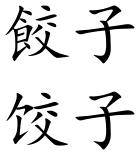
"Jiaozi" in Traditional (top) and Simplified (bottom) Chinese characters
|
|||||||||||||||||||
| Chinese name | |||||||||||||||||||
| Traditional Chinese | 餃子 | ||||||||||||||||||
| Simplified Chinese | 饺子 | ||||||||||||||||||
|
|||||||||||||||||||
| Manchu name | |||||||||||||||||||
| Manchu script | ᡤᡳᠶᠣᠰᡝ | ||||||||||||||||||
| Möllendorff | giyose | ||||||||||||||||||
Jiaozi (Chinese: 餃子) are a popular type of dumpling from China. People eat them often in China and other parts of East Asia. They are a very important dish during the Chinese New Year celebration. In northern China, people enjoy them all year round. Even though they are a big part of Chinese cooking, jiaozi are also loved in other Asian countries and in Western countries. Sometimes, the fried version is called potstickers. The name "potsticker" comes from the Chinese word Guotie, which means "pot stick".
Jiaozi usually have a filling made of ground meat or vegetables. This filling is wrapped inside a thin piece of dough. The edges of the dough are then pressed together to seal the dumpling. You can cook jiaozi in different ways: they can be boiled (shuǐ jiǎo), steamed (zhēng jiǎo), or pan-fried (jiān jiǎo). People traditionally eat them with a dipping sauce made from black vinegar and sesame oil. They can also be served in soup.
Contents
The History of Jiaozi
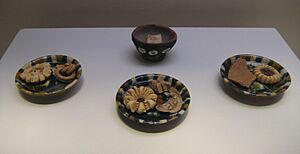
There are many fun stories in China about how jiaozi began and how they got their name.
One popular story says that jiaozi were invented a long time ago, during the Han dynasty (around AD 25–220). A famous doctor named Zhang Zhongjing supposedly created them. He called them "tender ears" because he used them to help people with frostbitten ears during a cold winter. He saw many poor people suffering because they didn't have warm clothes or enough food. Dr. Zhang cooked lamb, black pepper, and warming medicines in a pot. He chopped them up and put them inside small dough wrappers. He boiled these dumplings and gave them with the broth to his patients. People got better and celebrated the New Year by making their own "Jiao'er," just like Dr. Zhang's recipe.
Some people think jiaozi might have come from dumplings in Western Asia. In the Han dynasty (206 BC – AD 9), jiaozi were called jiaozi (角子). Later, during the Tang Dynasty (AD 618–907), jiaozi became even more popular. Chinese scientists have even found a bowl of jiaozi in ancient tombs from the Tang dynasty!
The name jiaozi might also come from their shape, which can look like a horn. The Chinese word for "horn" is jiao (Chinese: 角; pinyin: jiǎo). The original Chinese character for jiaozi looked like the word for "horn." Later, a new character was made just for this food.
Jiaozi also look like old Chinese silver or gold ingots called yuan bao, which were used as money. Because of this, eating jiaozi is thought to bring good luck and wealth. Many families eat them at midnight on Chinese New Year's Eve. Some cooks even hide a clean coin inside one jiaozi for someone lucky to find!
Today, people eat jiaozi all year round. They can be a part of breakfast, lunch, or dinner. They can be an appetizer, a side dish, or even the main meal. In China, small restaurants often serve jiaozi for breakfast. They are always served with a dipping sauce. This sauce can have vinegar, soy sauce, garlic, ginger, rice wine, hot sauce, and sesame oil.
Types of Jiaozi
Chinese dumplings, or jiaozi, are cooked in different ways:
- Boiled dumplings (simplified Chinese: 水饺; traditional Chinese: 水餃; pinyin: shuǐjiǎo; literally "water dumpling"): These are cooked in boiling water.
- Steamed dumplings (simplified Chinese: 蒸饺; traditional Chinese: 蒸餃; pinyin: zhēngjiǎo; literally "steam dumpling"): These are cooked using steam.
- Pan-fried dumplings (simplified Chinese: 煎饺; traditional Chinese: 煎餃; pinyin: jiānjiǎo; literally "dry-fried dumplings"): Also called "pot-stickers" (simplified Chinese: 锅贴; traditional Chinese: 鍋貼; pinyin: guōtiē; literally "pan stick"). They are fried until crispy on one side.
- Soup dumplings (simplified Chinese: 汤饺; traditional Chinese: 湯餃; pinyin: tāngjiǎo; literally "soup dumpling"): These are served in a tasty broth or soup.
There are also "egg dumplings" (simplified Chinese: 蛋饺; traditional Chinese: 蛋餃; pinyin: dànjiǎo; literally "egg dumpling"). These use egg instead of dough to wrap the filling.
What's Inside? Jiaozi Fillings

Since many families make jiaozi at home, each family has its own special recipe. The fillings and how they are made can be very different from one area to another.
Common meat fillings include pork, mutton, beef, chicken, fish, and shrimp. These are usually mixed with chopped vegetables. Popular vegetable fillings are napa cabbage, scallions (also called spring onions), leek, celery, spinach, mushrooms, black fungus, carrots, and garlic chives.
How to Fold Jiaozi

There are many ways to fold jiaozi. The most common and famous way is the pinched-edge fold, which makes a crescent shape. First, you put a spoonful of filling in the middle of a round wrapper. Then, you fold one half of the wrapper over to meet the other half, making a half-moon shape. You use your fingers to pinch one side of the wrapper, making small pleats. You repeat this on the other side, making sure the dumpling is sealed tightly. This creates the classic crescent-shaped jiaozi that many people love.
Different Kinds of Jiaozi Around the World
Guangdong Gaau Ji
In Cantonese language, jiaozi are called gaau ji. They are a common dish in dim sum meals, which are small plates of food served in Chinese restaurants. These gaau ji are usually smaller than northern jiaozi and have a thinner, almost see-through skin. They are typically steamed. Because the wrapper is so thin, it's harder to make at home, so people often buy them from stores or restaurants.
Many different fillings are used, but the most common is har gow (simplified Chinese: 虾饺; traditional Chinese: 蝦餃; Cantonese Yale: hā gáau; literally "shrimp dumplings"), which are shrimp dumplings. Other fillings can include scallop, chicken, tofu, or mixed vegetables.
Guotie (Potstickers)
Guotie (Chinese: 鍋貼; pinyin: guōtiē; literally "pot stick"), also known as potstickers, are a type of pan-fried dumpling from Northern China. They are popular as street food, appetizers, or side dishes. Guotie are often longer and sometimes have open ends, unlike other pan-fried dumplings. They are fried directly on the bottom side, making that part crispy, while the top part is steamed.
The filling for Guotie usually has pork (or sometimes chicken or beef), cabbage, scallions, ginger, Chinese rice wine, and sesame oil.
To cook Guotie, a small amount of water is added to the wok (a round-bottomed pan) after frying the bottom. Then, the wok is covered. This way, the bottom of the dumplings gets crispy from frying, and the top part gets soft from steaming. This gives them a nice mix of textures.
History of Guotie
Some stories say Guotie have been around for over 4,000 years! However, the first time they were written about was during the Chinese Song Dynasty (AD 960–1280). Legend says that an imperial chef accidentally burned some dumplings. Instead of throwing them away, he served them to the Emperor, and they became a hit!
Gyōza (Japanese Version)
The Japanese word gyōza (ギョーザ) comes from the Chinese word for jiaozi. After World War II, Japanese soldiers who came back from China brought gyōza recipes home.
The main differences between Japanese gyōza and Chinese jiaozi are that gyōza often have a stronger garlic flavor. Also, gyōza wrappers are usually thinner, often made by machines. Gyōza are usually served with a soy-based sauce that has rice vinegar and/or chili oil. The most common filling is minced pork (or chicken/beef), cabbage, Asian chives, sesame oil, garlic, and ginger.
The most popular way to cook gyōza is yaki-gyōza, which means pan-fried. The dumpling is first fried on one flat side to make it crispy. Then, water is added, and the pan is covered so the top part of the dumpling gets steamed. This is the same cooking method as Chinese guotie or "potstickers." Other ways to cook them include boiling (sui-gyōza) and deep frying (age-gyōza).
Momo (Tibetan Version)
The Tibetan version of these dumplings is called momo (Tibetan: མོག་མོག་). The word "momo" comes from a Chinese word meaning "steamed bread." When making momo, the dough is usually filled with ground water buffalo meat. Sometimes, ground lamb or chicken is used instead. People add finely chopped onion, minced garlic, fresh minced ginger, cumin powder, salt, and coriander for flavor. Momo are often served with a sauce made from cooked tomatoes, flavored with Sichuan pepper and minced red chilies.
Jiaozi vs. Wonton
It's easy to mix up jiaozi with wontons, but they are different! Jiaozi have a thicker skin and are usually flatter and more oval-shaped. They are typically eaten with a dipping sauce made of soy-vinegar or chili sauce. Wontons, on the other hand, have a thinner skin and are usually served in a broth or soup. The dough for jiaozi and wonton wrappers also use different ingredients.
Images for kids
See also
 In Spanish: Jiaozi para niños
In Spanish: Jiaozi para niños


